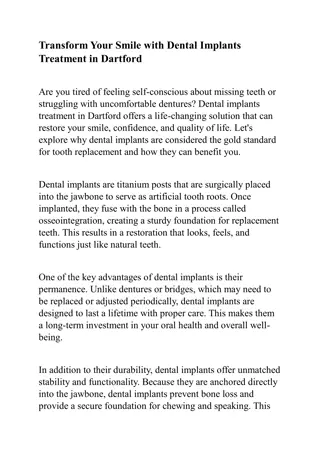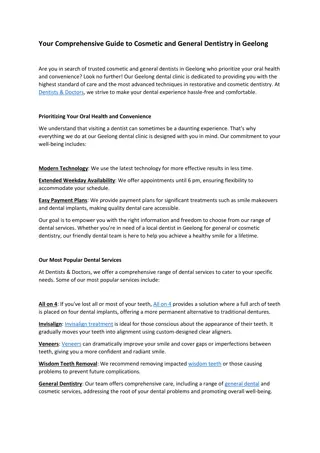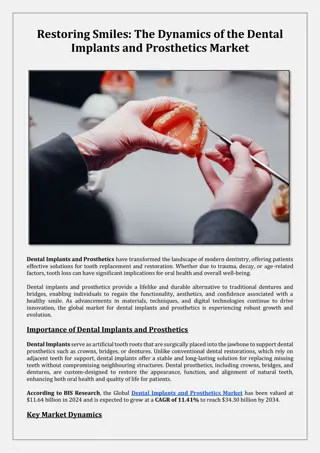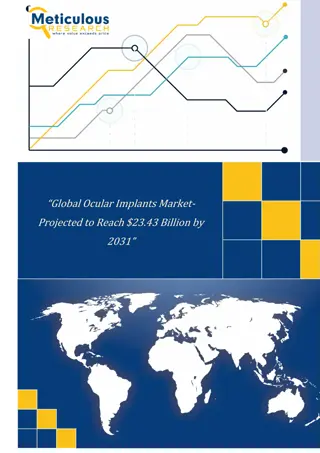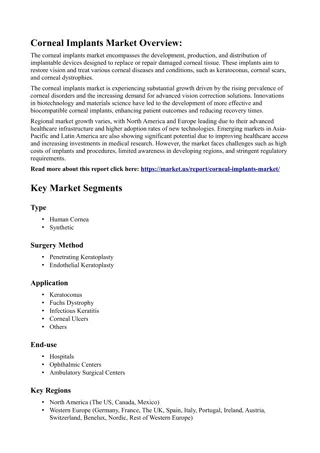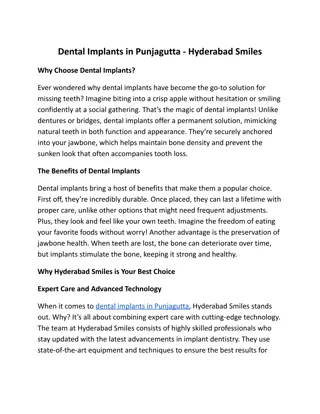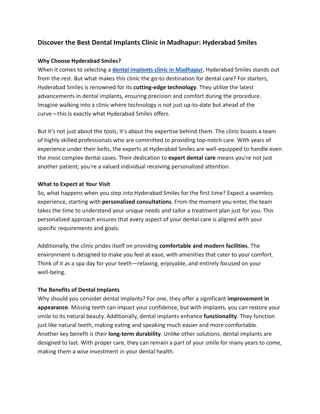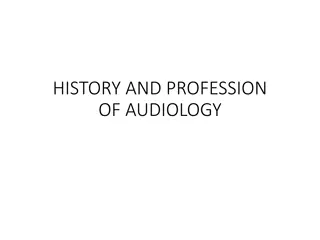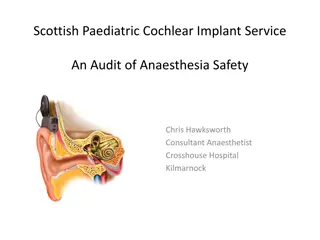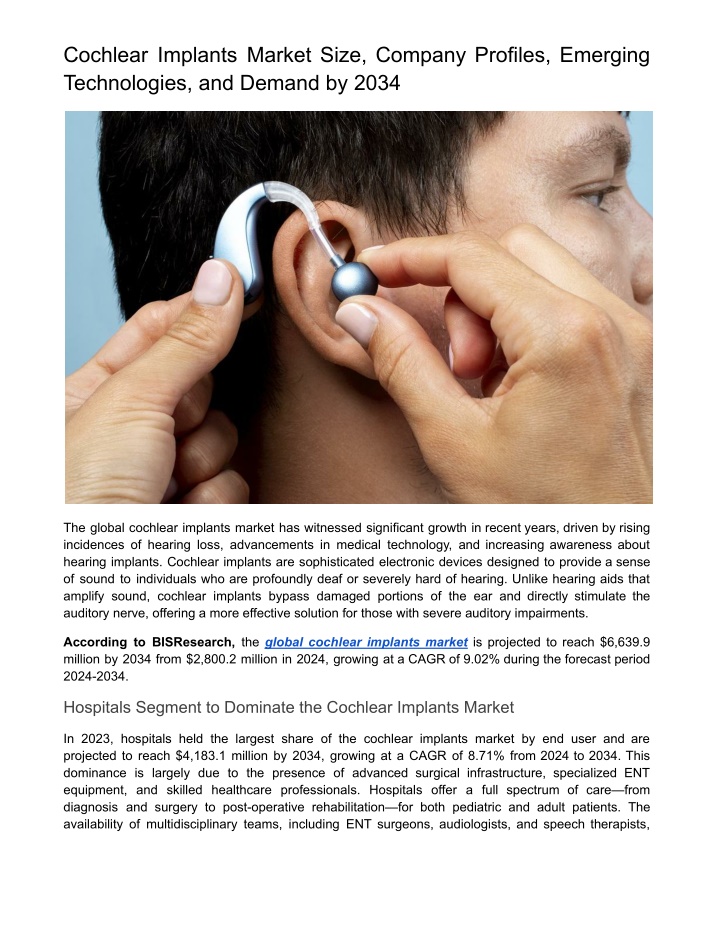
Cochlear Implants Market Challenges & Opportunities
The global cochlear implants market, initially valued at $2,424.4 million in 2023, is set to witness substantial growth, projected to surge to $6,639.9 million by 2034, marking a remarkable CAGR of 9.02% over the period from 2024 to 2034.nnRead Rep
Download Presentation

Please find below an Image/Link to download the presentation.
The content on the website is provided AS IS for your information and personal use only. It may not be sold, licensed, or shared on other websites without obtaining consent from the author. If you encounter any issues during the download, it is possible that the publisher has removed the file from their server.
You are allowed to download the files provided on this website for personal or commercial use, subject to the condition that they are used lawfully. All files are the property of their respective owners.
The content on the website is provided AS IS for your information and personal use only. It may not be sold, licensed, or shared on other websites without obtaining consent from the author.
E N D
Presentation Transcript
Cochlear Implants Market Size, Company Profiles, Emerging Technologies, and Demand by 2034 The global cochlear implants market has witnessed significant growth in recent years, driven by rising incidences of hearing loss, advancements in medical technology, and increasing awareness about hearing implants. Cochlear implants are sophisticated electronic devices designed to provide a sense of sound to individuals who are profoundly deaf or severely hard of hearing. Unlike hearing aids that amplify sound, cochlear implants bypass damaged portions of the ear and directly stimulate the auditory nerve, offering a more effective solution for those with severe auditory impairments. According to BISResearch, the global cochlear implants market is projected to reach $6,639.9 million by 2034 from $2,800.2 million in 2024, growing at a CAGR of 9.02% during the forecast period 2024-2034. Hospitals Segment to Dominate the Cochlear Implants Market In 2023, hospitals held the largest share of the cochlear implants market by end user and are projected to reach $4,183.1 million by 2034, growing at a CAGR of 8.71% from 2024 to 2034. This dominance is largely due to the presence of advanced surgical infrastructure, specialized ENT equipment, and skilled healthcare professionals. Hospitals offer a full spectrum of care from diagnosis and surgery to post-operative rehabilitation for both pediatric and adult patients. The availability of multidisciplinary teams, including ENT surgeons, audiologists, and speech therapists,
ensures comprehensive care and favorable outcomes, making hospitals the preferred setting for cochlear implant procedures. What are the key drivers of the cochlear implants market? Hearing loss is increasing globally, driven by aging populations, noise exposure, genetics, and untreated infections. Over 1.5 million people worldwide currently experience some form of hearing impairment, according to the WHO. This number is projected to rise due to ongoing demographic and environmental changes. Early diagnosis and growing public awareness are improving treatment rates. As a result, the adoption of hearing aids and cochlear implants is steadily increasing, especially for severe to profound cases. Request A Detailed Sampleon the Cochlear Implants Market! Which regions are seeing the fastest growth in the cochlear implants market? In 2023, North America held the dominant position in the global cochlear implants market. However, the Asia-Pacific region is anticipated to experience the highest growth rate, with a projected CAGR of 10.53% during the forecast period from 2024 to 2034. This growth is driven by factors such as high healthcare expenditure, the presence of advanced medical infrastructure, and strong government support for hearing loss treatment initiatives. Additionally, increasing awareness of hearing restoration solutions and the rising adoption of bilateral cochlear implantation are further contributing to market expansion. The growing elderly population and the increasing prevalence of age-related hearing loss are also fueling demand, particularly among older adults seeking cochlear implants to enhance their quality of life. What are the major challenges facing the cochlear implants industry? Despite their effectiveness, cochlear implants remain financially out of reach for many, especially in low- and middle-income countries. The total cost of a single procedure including the device, surgery, and rehabilitation can range from $50,000 to $100,000 in the U.S., with similarly high prices elsewhere. Without insurance or financial aid, this expense is prohibitive. As a result, only 5 10% of eligible candidates globally receive implants, highlighting a major unmet medical need driven by cost and limited access to treatment. Opportunities in the Cochlear Implants Market Emerging markets offer strong growth potential for the cochlear implants industry, driven by improved healthcare infrastructure, growing awareness of hearing loss treatments, and rising disposable incomes. Countries across Asia-Pacific, Latin America, and Africa are experiencing increased demand as governments and healthcare providers enhance access to advanced medical technologies. Efforts such as subsidized healthcare, broader insurance coverage, and collaborations with international medical device companies are further improving affordability and accessibility, positioning these regions as key contributors to the market s future expansion.
Who are the key players in the cochlear implants industry? Cochlear Limited. Sonova Holding AG. Zhejiang Nurotron Biotechnology Co., Ltd. (Nurotron) MED-EL Medical Electronics Get Insight on the Medtech Market Research Reports According to Principal Analyst BIS Research, The cochlear implants market is set for significant expansion, fueled by the growing incidence of hearing loss, especially among the elderly. Technological advancements such as compact, energy-efficient processors, AI-driven sound optimization, and wireless capabilities are enhancing both outcomes and user satisfaction. Rising awareness and earlier diagnosis are prompting more patients to choose cochlear implants over traditional hearing aids. Supportive government policies, improved insurance coverage, and increased private investment are boosting accessibility. Innovations in biocompatible materials, minimally invasive procedures, and smart features continue to evolve, positioning cochlear implants as a preferred, long-term solution for individuals seeking reliable hearing restoration.



